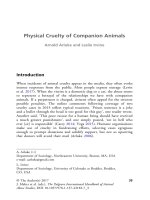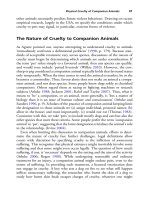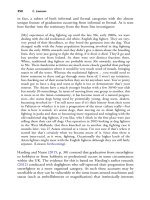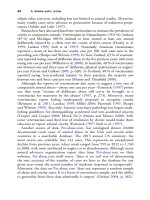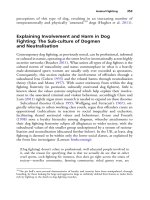The palgrave international handbook of a 179
Bạn đang xem bản rút gọn của tài liệu. Xem và tải ngay bản đầy đủ của tài liệu tại đây (25.16 KB, 1 trang )
Breeding and Rearing Farmed Animals
171
resource for human ends, and we might speak of the exploitation of the
properties of animal bodies, genetically altered to withstand intensive agricultural systems or the labour power of domesticated animals in agriculture
(such as in breeding and lactation), for example. Marginalisation is most
broadly applicable, referring to human centrism.
I have also suggested that five sets of social institutions and their related
processes network to form the social system of relations I call anthroparchy.
The first set of anthroparchal relations is production, wherein the breeding
and raising of animals for food can be seen in the interlinked institutions and
processes of breeding and growing which operate in a complex network of
local, regional and global relations. The second relational arena is domestication which has characterised human engagements with other species for
millennia through the selective breeding of certain kinds of plants and
animals. The last two centuries have seen intensification of such processes,
for example, in terms of reproductive interventions in animal food production. The third arena is political. States and international organisations can
act as direct or indirect agents of anthroparchy; for example, by subsidising
animal farming, or contest and change forms of abuse by making certain
practices unlawful (such as the use of battery cages). Fourth, we have systemic
violence, which as we have seen in the previous section, is embedded in the
production systems of ‘animal food’. Finally, anthroparchal social relations
are characterised by cultures of exclusive humanism which may, for example,
encourage certain practices such as animal food consumption.
The breeding and raising of farmed animals illustrates a specific site in
which anthroparchal institutions, processes and practices may be evidenced.
The case for the material intersections of class and race has been well made by
those such as Nibert (2002) and Torres (2007). However, these material
practices, can also be understood as co-constituted through gendered relations. The breeding and growth of non-human animals for ‘meat’ reflects the
complex intersections of a range of relations of social power.
Responses
Given the prevalence of the abuse of animals in farming generally and in
increasing degree and scale through intensive industrial modes of breeding
and rearing, one might expect reactions from governing bodies, non-governmental and civil society organisations. This section will suggest that the most
energetic responses to counter abuse in (and of) animal agriculture comes
from civil society, but this has had a limited impact on national and
